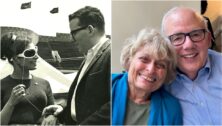Danish Duo Rewrites History of Kissing with 2400 B.C. First Smooch Discovery

A married pair of researchers have rewritten the history of kissing with the help of the Barton Cylinder, a Sumerian artifact from around 2400 B.C., writes Franz Lidz for The New York Times.
In 2022, Sophie Lund Rasmussen and Troels Pank Arboll were discussing a new genetic study that pinpointed South Asia as the origin of kissing and traced the first literary smooch to Vedic Sanskrit manuscripts from 1500 B.C.
“I told Sophie that I knew of even older accounts written in both the Sumerian and Akkadian languages,” said Arboll.
The Danish husband-and-wife team proposed that the oldest account of kissing can be found etched into the Barton Cylinder. The clay tablet was unearthed in 1899 in the ancient Sumerian city of Nippur and dates to around 2400 B.C.
Today, it is housed in Penn Museum at the University of Pennsylvania.
The artifact describes the Sumerian creation myth and a kiss shared between two deities after intercourse.
The two scientists also maintained that kissing did not emerge abruptly at a specific point of origin, and was a well-established part of romance in the Middle East since at least the late third millennium B.C.
Gonzalo Rubio, an Assyriologist at Penn State University, praised the pair for essentially rewriting the history of kissing.
“They aimed to set the record straight and came to correct such a reductionist approach to human behavior,” he said.
Read more about the history of kissing in The New York Times.
__________
Connect With Your Community
Subscribe to stay informed!
"*" indicates required fields































![95000-1023_ACJ_BannerAd[1]](https://vista.today/wp-content/uploads/2023/03/95000-1023_ACJ_BannerAd1.jpg)
















